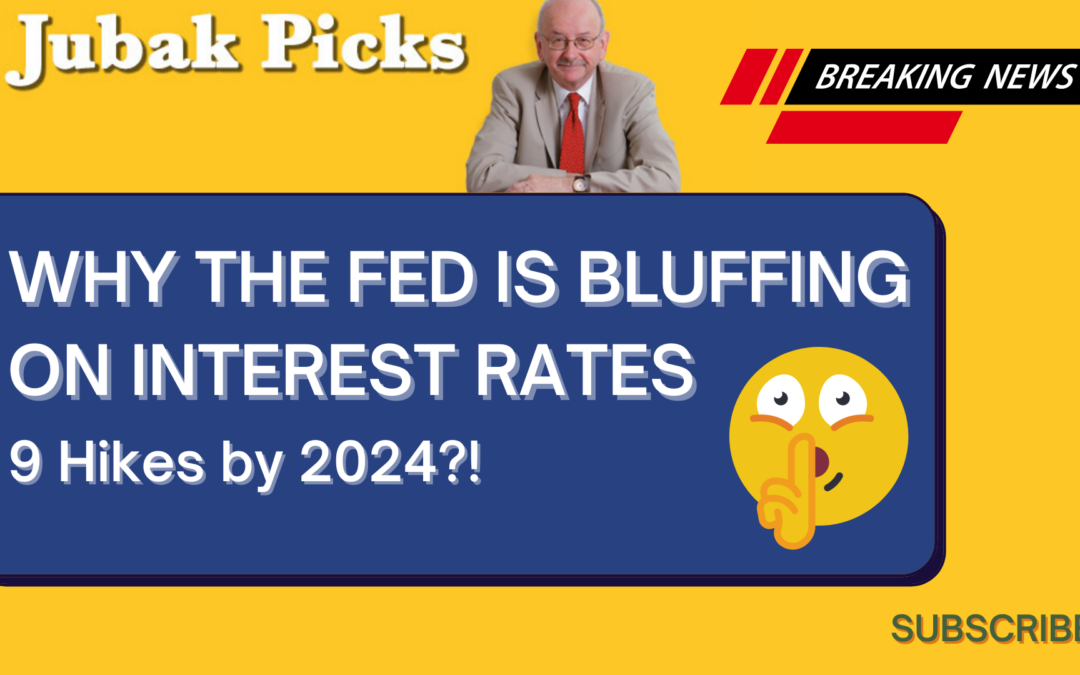
December 16, 2021 | Daily JAM, Mid Term |
Looking ahead at 2022, it’s not too hard to list the forces that will drive the financial markets. Putting those forces together and blocking out a schedule for their effects on the stock market. Well, that’s a lot harder. But let me try. Here’s my take on what’s ahead for 2022–Part 1 anyway

December 15, 2021 | Daily JAM, Short Term, Videos, Volatility |
I’m starting up my videos on JubakAM.com again–this time using YouTube as a platform. My eighty-first YouTube video “Why the Fed is bluffing on interest rates” went up today.

December 12, 2021 | Daily JAM, Friday Trick or Trend, Mid Term |
In late November non-resident cash flows to emerging market assets, excluding China, turned negative for the first time since March 2020 and the Pandemic global economic dip, according to the Institute of International Finance.

December 11, 2021 | Daily JAM, Short Term |
The Federal Reserve’s Open Market Committee meets on Wednesday, December 15, and that the central bank’s interest rate setting say something about the speed at which it will wind down its monthly purchases of Treasuries and mortgage-backed securities. We’re pretty sure, but we don’t know with absolute certainty, that the Fed will announce a speed up of that wind down that would see the process of ending all of the Fed’s monthly purchases a month two early. June, maybe. That could be a big deal because the financial markets are convinced that the Fed would have to end its purchases of Treasuries before beginning any interest rate increase in, say, the last quarter of 2022. I think, but I’m certainly not positive, that the markets won’t show much reaction to the news

December 10, 2021 | Daily JAM, Morning Briefing |
Stocks rose today, December 10, as a huge jump in CPI inflation exactly matched economists’ projections. As they say on the basketball court, “No surprise; no foul.” The Consumer Price Index (CPI) climbed at a 6.8% annual rate in November.

November 30, 2021 | Daily JAM, Morning Briefing |
Right now the stock and bond markets can’t decide if the Omicron Variant will crush the global economy badly enough to lead the Federal Reserve to delay its timetable for raising interest rates or if the U.S. economy is so strong and inflation so persistent that Jerome Powell and company will be pushed to accelerate the Fed’s tightening. Which makes Friday’s jobs report for November even more important than usual since it might provide the tipping data to send the Fed’s decision one way or the other. Right now economists at Argus forecast that the economy added 550,000 new jobs in November. That would be an increase from the 531,000 jobs created in October and from the 32,000 created in August.

November 30, 2021 | Daily JAM, Morning Briefing |
Federal Reserve Chair Jerome Powell retired the word “transitory” to describe stubbornly high inflation in testimony today in front of the Senate Banking Committee. And, Powell continued, the Fed might accelerate the pace at which it is winding down its purchase of Treasuries and mortgage-backed assets. “It is appropriate, I think, for us to discuss at our next meeting, which is in a couple of weeks, whether it will be appropriate to wrap up our purchases a few months earlier.” The Fed is currently scheduled to complete its asset-purchase program in mid-2022

November 23, 2021 | Daily JAM, Mid Term, Videos |
I’m starting up my videos on JubakAM.com again–this time using YouTube as a platform. My seventy-second YouTube video “Recalculating the interest rate outlook for 2022” went up today.

November 22, 2021 | Daily JAM, KBWB, Perfect Five-ETFs |
Even if mere mortals don’t know whether a second term as Fed chair for Jerome Powell would accelerate the schedule for interest rate increases, both the yen/dollar market and bank stocks know.

November 22, 2021 | Daily JAM, Morning Briefing |
This morning President Joe Biden announced that he will renominate Jerome Powell to another four-year term as chairman of the Federal Reserve. Wall Street sounds like it’s generally happy with the move–continuity is usually seen as good by the financial markets–although bond yields are up as of 2:30 p.m. this afternoon with the 10-year Treasury yield climbing to 1.62%, a gain of 7 basis points. That’s a reflection, in my opinion, of a little bond market disappointment that Biden didn’t nominate Lael Brainard to replace Powell, She was seen as more likely to hold interest rates lower for longer than Powell. Powell’s nomination faces opposition from progressive Democrats who don’t like the financial deregulation that has continued during his term or who don’t think the U.S. central has done enough on global warming. Powell also faces opposition from conservative Republicans because they believe the Fed should be moving faster to stomp on inflation. My view is a little different than either Democratic or Republican objections. I think that if Biden had been more confident of the economy recovery he would have nominated Brainard. That would have put a Biden stamp on the U.S. central bank.

November 3, 2021 | Daily JAM, Morning Briefing |
After today’s meeting of the Federal Reserve’s Open Market Committee the U.S. central bank said it would start slowing the pace of its monthly $120 billion in asset purchases this month. The slowdown would take place at a rate of $15 billion a month, which implies an end to the program by the middle of 2022.

October 26, 2021 | Daily JAM, Morning Briefing |
As bond yields have tumbled because of the Federal Reserve’s lower interest rates for longer monetary stance, investors have compensated by buying longer duration bonds. The logic is pretty simply. A one-year Treasury now yields 0.11%. A two-year Treasury pays 0.45%. A five-year Treasury yields 1.18%. The benchmark 10-year Treasury was paying 1.61% at the close today, October 26. Want more yield? You can buy the 30-year Treasury for a yield of 2.04%. The problem is that the longer the duration of a bond–the more time until maturity–the bigger the downward move in bond prices if/when the Federal Reserve decides to raise interest rates or if/when the financial markets decide to anticipate a Fed move by selling bonds ahead of any move by the U.S. central bank.












